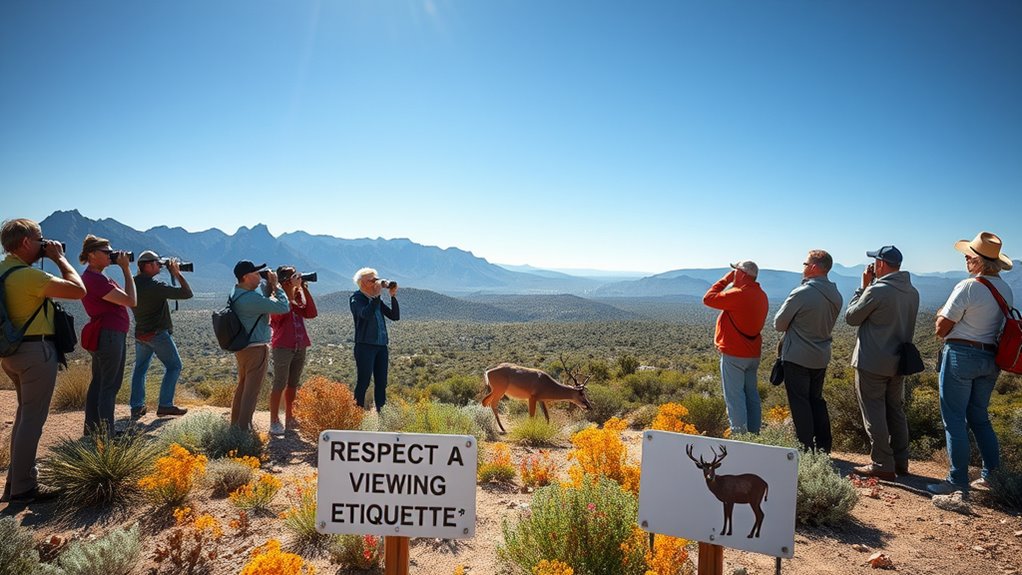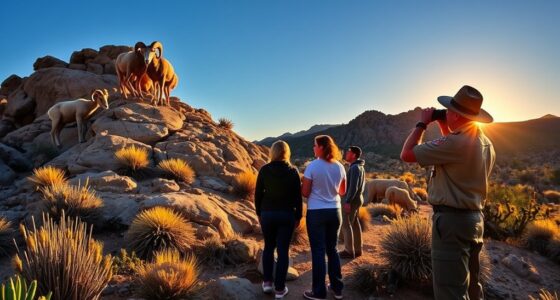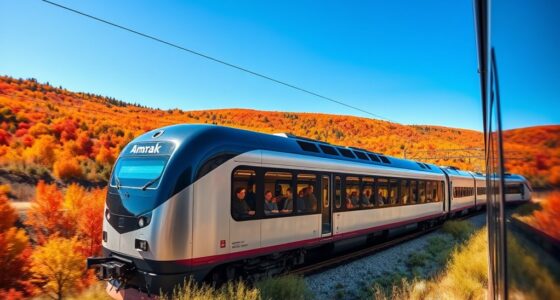When wildlife viewing in Big Bend National Park, avoid feeding animals to keep them wild and independent. Maintain silent observation to reduce stress on them, and use binoculars or zoom lenses for a closer look without intruding. Respect their space by staying at a safe distance and protect their habitat. Enhance your experience by learning about the local wildlife behaviors. This way, you’ll not only enjoy your time but also contribute to conservation efforts in the park.
Key Takeaways
- Avoid feeding wildlife to maintain their natural foraging instincts and prevent unhealthy dependence on human food.
- Maintain silence and low voices to minimize stress and disturbances to wildlife during observation.
- Use binoculars or zoom lenses for closer views without intruding on animals’ territory.
- Respect animals’ space by keeping a safe distance to ensure their safety and preserve their habitat.
- Enhance your observation experience by understanding wildlife behavior and its context within the ecosystem.

When you venture into nature to observe wildlife, it’s essential to respect both the animals and their habitat. In places like Big Bend National Park, you find a unique ecosystem teeming with diverse species. To truly appreciate this environment, you need to practice proper wildlife viewing etiquette. One of the most critical aspects is to avoid feeding wildlife. While it might seem harmless to toss a few crumbs or scraps to a curious animal, this practice disrupts their natural foraging instincts and can lead to unhealthy dependence on human food. Animals that become accustomed to human handouts can lose their natural fear of people, making them more vulnerable to danger. By refraining from feeding them, you help maintain their natural behaviors and keep them safe.
Another essential component of wildlife viewing is maintaining silent observation. Your presence in the park can be exciting for you, but it’s crucial to remember that the wildlife around you may perceive you as a potential threat. When you keep your voice low and minimize sudden movements, you allow animals to behave naturally without the stress of human interference. Imagine standing quietly, watching a family of deer grazing in a meadow, or observing a hawk soaring overhead. These moments are only possible when you respect their space and remain unobtrusive.
Using binoculars or a camera with a zoom lens can enhance your experience without intruding on their territory. Instead of getting too close, which can frighten or agitate the animals, you can enjoy watching them from a distance. This distance not only protects the animals but also allows you to capture stunning images that reflect their natural behaviors in the wild. Furthermore, understanding industry trends in wildlife behavior can greatly enrich your observations and increase your appreciation for these magnificent creatures.
Frequently Asked Questions
What Types of Wildlife Can I Expect to See in Big Bend?
In Big Bend, you can expect to see a diverse array of native species. Keep an eye out for desert bighorn sheep, javelinas, and roadrunners. If you’re into bird watching, you’ll love spotting the colorful painted bunting or the majestic golden eagle soaring overhead. The park’s unique ecosystems provide habitats for many fascinating creatures, making it a perfect destination for wildlife enthusiasts like you. Enjoy the experience and capture those unforgettable moments!
Are There Specific Viewing Times That Are Best for Wildlife Sightings?
If you’ve ever glimpsed the dawn chorus of nature, you know the magic that early mornings bring. The best viewing hours for wildlife are typically at dawn and dusk when activity peaks. Animals are more active during these cooler times, making your chances of spotting them much higher. So, grab your binoculars and head out early or stay late; you’ll discover a world bustling with life, just waiting for you to witness.
Can I Bring My Pet While Wildlife Viewing in the Park?
You can’t bring your pet while wildlife viewing in the park due to strict pet restrictions. This policy helps guarantee both animal safety and the well-being of your pet. Wildlife can be unpredictable, and having pets around may cause stress or dangerous situations for both them and the animals. It’s best to leave your furry friend at home so you can fully enjoy the natural beauty and wildlife without any distractions.
Is There a Fee for Wildlife Viewing in Big Bend National Park?
When it comes to enjoying nature, you won’t find any hidden fees in Big Bend National Park. You’ll need to pay park entrance fees, which cover access to the park, but there aren’t any additional charges specifically for wildlife viewing. However, if you plan to engage in certain activities, you might need wildlife viewing permits. Overall, it’s a fantastic way to experience the great outdoors without breaking the bank!
Are There Guided Tours Available for Wildlife Viewing Experiences?
Yes, there are guided tour options available for wildlife viewing experiences. You can join programs led by wildlife experts who share their knowledge about the local fauna and ecosystems. These tours often provide unique insights and up-close encounters that you wouldn’t get on your own. Make sure to check the park’s schedule for upcoming wildlife expert programs, as they can enhance your experience and help you appreciate the area’s natural beauty even more.
Conclusion
As you commence on your wildlife viewing adventure in Big Bend National Park, remember that respect is the key to harmony in nature. By keeping a safe distance, minimizing noise, and leaving no trace, you’re not just an observer but a guardian of these wild treasures. Like a gentle breeze that whispers through the trees, your thoughtful actions can create an atmosphere where both you and the wildlife thrive. Enjoy every moment, and let nature’s wonders unfold before you!










